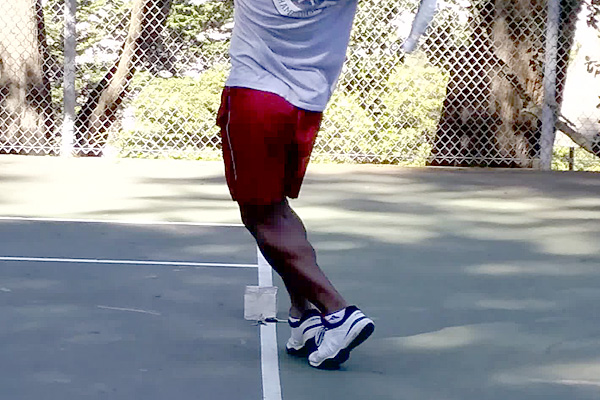Posts Tagged ‘technique’
 Ask Marla #11 – Breaking The Foot Fault Habit, Part 1 – Footwork
Ask Marla #11 – Breaking The Foot Fault Habit, Part 1 – Footwork

It’s been a while since my last “Ask Marla”, so I’m offering up a two-part piece on a matter of concern to all tennis players: foot faults. Many players foot fault, but most don’t know how to stop. So I asked Marla about foot faults, and some tips to help fix them.
Part 1 covers tips to correct foot faults, and Part 2 will cover other aspects of the serve that can contribute to foot faults, such as chasing your toss or inadequate knee bend.
Question: Do you have any tips to help players check if they foot-fault and fix it if they do?
Answer: The easiest thing a player can do is to back away from the baseline before hitting their serve. I don’t like doing that, however, because you give up valuable ground if you only have a marginal serve. The better alternative is to figure out which feet step over the line, and then work to stop them.
Try setting tennis balls in front of your feet when you serve: one in front of lead foot and one to side where back foot pulls up. Whichever ball moves (i.e. gets kicked or stepped on) will let you know the offending foot (or feet). Afterward, you can adjust your serve accordingly to better anchor your feet (for greater serve accuracy), and to better minimize potential foot faults.
Of course, the best option for checking foot faults is to have a friend take video or pictures of your serve along the baseline. This will clearly show which feet cross the line on your serve.
(SFTF Note: I’ve also struggled with foot faults. After watching a ton of matches with top-ranked players, I noticed that many barely move their feet when serving. So I’ve recently begun anchoring my front foot, the usual offender, to help clean up my service footwork. I also tried Marla’s tennis ball option to catch any movement across the line, but also used other items such as my keychain, a spare racquet, and a brick.
The brick actually proved to be the most helpful for me because of its’ size. There’s no way I could deny hitting it on the line if I crossed. The pictures at right shows a practice serve with the brick. The picture series below shows my cleaner footwork afterward. All pictures were taken by my phone on a tripod. The brick is a great tool, but pictures are indeed worth a thousand words! Whatever option you use on the baseline, try to supplement it with pictures or videos.
Chasing your toss across the line, or losing power because of knee bend now that your feet are anchored? Stay tuned for Part 2.
Got a tennis question? Send it via email or tweet for “Ask Marla”.
About Marla
Marla Reid is a respected tennis pro/coach in the San Francisco Bay Area. She’s coached nationally-ranked teams and players, and has over 15 years of experience at the NCAA Division I, II, and III levels. Marla owns and operates City Racquet Shop in San Francisco CA.
About City Racquet Shop
City Racquet Shop offers, superior products/services, outstanding customer service, and a community-oriented destination for tennis players to shop, hang out and talk about tennis.
City Racquet Shop online: www.cityracquetshop.com
City Racquet Shop on Yelp: http://www.yelp.com/biz/city-racquet-shop-san-francisco
City Racquet Shop on Facebook: https://www.facebook.com/cityracquetshop
 Tips for Better Tennis Fitness from Jackson Bloore
Tips for Better Tennis Fitness from Jackson Bloore
For the past couple of weeks I’ve had the pleasure of getting to know Jackson Bloore, a personal fitness trainer here in San Francisco at DIAKADI Body.
Besides the obvious (stunning good looks with an Adonis body owing to his work as a fitness model), Jackson is one of the nicest, most approachable guys you’ll ever want to meet. He’s also in the best shape I’ve ever seen from someone who’s not a dancer or professional athlete.
I’ve watched his workouts at my gym over the past several months, and have been tremendously impressed by their caliber and quality. Though he has the muscular physique of a bodybuilder, trust me when I say that his workouts are about more than simply lifting weights.
It’s also clear from watching him (and checking out his training videos) that he has a core belief about how to train others that he applies equally to himself, and his own workouts. This is fairly notable at a gym where you rarely see trainers “practice what they preach”.
While chatting, I mentioned that I’ve been struggling lately with on-court injuries. Though I’m in great shape by most standards, I’m pretty much at a loss on how to best train my 50-year old ex-dancer body for the rigors of my tennis game. After all, core work and biking only go so far.
We set a time to meet so that Jackson could offer some suggestions on how I could better use my gym time to prepare my body for tennis. What followed was a mind-blowing 10-15 minute chat, with specific exercise suggestions, that gave me great hope for lessening injuries while improving my tennis fitness in 2014.
I asked if I could share some of his insights with my readers, and he agreed. So as his time allows, I’ll share occasional training tips to help you all with various aspects of tennis fitness.
I know this won’t have the same impact as ‘Oprah’s Favorite Things’, but I can’t say enough about Jackson’s knowledge, professionalism, and easy-going demeanor. You can contact Jackson for consultation/training at jackson@actionjacksonfitness.com. He does in-person training as well as Skype consultations. If you’re struggling with injuries and need help with your training regimen, give him a shot.
Until next time, enjoy these two training vids featuring Jackson doing his thing.






